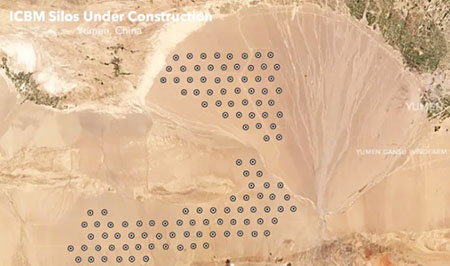by WorldTribune Staff, February 7, 2023
China now has more land-based intercontinental-range missile launchers than the United States, the new commander of U.S. Strategic Command, Air Force Gen. Anthony J. Cotton, told the Senate and House Armed Services Committees in a Jan. 26 letter.
Stratcom oversees U.S. nuclear forces.

Republicans in Congress have said they view the number of ICBM launchers as a portent of the scale of communist China’s longer-range ambitions and are urging the Biden administration to expand U.S. nuclear forces to counter China and Russia.
“China is rapidly approaching parity with the United States,” said Rep. Mike Rogers, the Alabama Republican who chairs the House Armed Services Committee. “We cannot allow that to happen. The time for us to adjust our force posture and increase capabilities to meet this threat is now.”
Rogers said the New START treaty, which places limits on long-range forces, is blocking the U.S. from building up its arsenal to deter Russia and China. The treaty, which China isn’t party to and the U.S. believes Russia is in violation of, is set to expire in 2026.
Even if Russia is violating New START, arms-control proponents say that “rather than trying to surpass China’s and Russia’s nuclear forces, the U.S. has more to gain by trying to preserve treaty limits with Russia and by attempting to draw Beijing into a discussion of nuclear-arms control,” Michael R. Gordon reported for the Wall Street Journal on Tuesday.
“It’s in our national interest to keep the Russians under the New START limits. We need to complete our nuclear modernization according to plan, not pile on new requirements,” said Rose Gottemoeller of Stanford University, who negotiated New START for the Obama administration in 2009 and 2010.
Related — Being nice was bad strategy: China’s nuclear breakout blamed on accommodationist policies, January 11, 2023
The Biden administration has indicated it wants to use a mix of arms control arrangements and upgraded nuclear forces.
“By the 2030s the United States will, for the first time in its history, face two major nuclear powers as strategic competitors and potential adversaries,” the Pentagon said in a policy document known as the Nuclear Posture Review last year.
Gordon noted that U.S. lawmakers “are involved in an increasingly heated debate about how best to counter Beijing, including the Pentagon’s response to the Chinese surveillance balloon that recently traversed the U.S. and hovered over Montana, where a portion of the American military’s ICBM arsenal is deployed.”
China, which has rejected arms-control talks with the U.S., is on track to field about 1,500 nuclear warheads by 2035, up from an estimated operational stockpile of more than 400 in 2021, according to last year’s Nuclear Posture Review.
“The growth in China’s nuclear forces has raised concerns that it might use the threat of nuclear escalation to dissuade Washington from rushing to aid Taiwan during a crisis. The U.S. has refrained from providing Ukraine with long-range weapons or sending U.S. forces to the country because it wants to avoid a direct clash with a nuclear-armed Russia,” Gordon wrote.
China operates a fleet of mobile ICBM launchers and has about 20 liquid-fueled, silo-based missiles. It is also building three ICBM silo fields that are intended to house at least 300 modern solid-fueled missiles.
Researchers have debated whether China plans to fill all of the silos with nuclear-tipped ICBMS, whether some might be left empty or whether some might be filled with conventionally armed systems.
Hans Kristensen of the Federation of American Scientists said commercial satellite images of the Chinese silo fields provide no indication that China’s military has been training to load the new silos with ICBMs or conducting exercises at the silo fields.
“They are building a significant number of silos, but we don’t know how many missiles or warheads they are going to put in them,” Kristensen said.
Gordon noted that “the working presumption among most U.S. officials, however, is that all of the silos will be filled with nuclear-tipped intercontinental missiles over the next decade or so.”
Action . . . . Intelligence . . . . Publish
